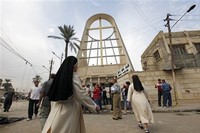By Anna Arco on Wednesday, 15 December 2010
Three Anglican nuns at Walsingham have left their community after they expressed interest in joining a personal ordinariate.
The nuns from the Priory of Our Lady of Walsingham have began a period of private discernment after they decided that they wanted to join any future English ordinariate.
In a joint statement, the nuns explained their situation. They said: "On December 2 2010 Sister Wendy Renate, Sister Jane Louise and Sister Carolyne Joseph left the Priory of Our Lady in Walsingham for a period of discernment with the intention of joining the ordinariate when established. We ask prayers for ourselves and for the Sisters remaining at the Priory of Our Lady."Ł
The community, which numbered seven nuns belonging to the Society of St Margaret, reportedly voted four to three against joining the ordinariate. The three nuns who left the community are its youngest members. The priory is an autonomous house of the Society of St Margaret and is not linked to the Anglican shrine at Walsingham, which is under the administration of Rt Rev Lindsay Urwin, the former Bishop of Horsham.
Fr Peter Geldard, a former Anglican who has been involved with the ordinariate, said: "Historically Anglican religious are the product of the Anglo-Catholic revival 175 years ago and in the past were very committed to Catholic unity. It has always been a source of surprise to me that so few Anglican religious seem to be interested in Catholic unity or the ordinariate today.
"The community seems to have been split down the middle, with the younger ones committed to the ordinariate while the older ones don't seem to want to rock the boat."Ł
According to Anglo-Catholic sources, the nuns were told to leave the convent "at great speed with next to nothing"Ł when they voiced their interest in taking up the offer made in the Pope's Apostolic Constitution Anglicanorum coetibus. Fr Geldard said: "One could see the nuns' decision to go ahead as encouraging because it shows the level of their commitment that they are ready to take to the sacrificial road.
"I believe they have been taken in by a Catholic community and are currently discerning whether there is in fact a Catholic community they could join which has a similar charism to their old community."Ł
They are believed to have taken refuge in the Catholic Community of Our Lady of Walsingham in Brentwood diocese.
The nuns, who fall under the episcopal oversight of the Rt Rev Peter Wheatley Bishop of Edmonton, broke away from the East Grinstead Society of St Margaret in the 1990s over the ordination of women and settled in Walsingham.
Bishop Wheatley could not be reached for comment as The Catholic Herald went to press.
Pope Benedict XVI's offer in Anglicanorum coetibus extends to religious orders as well as groups of lay people with clergy.
The document says that the ordinary who leads the ordinariate, can set up new institutes of consecrated Life and societies of apostolic life. It also says: "Institutes of consecrated life originating in the Anglican Communion and entering into full communion with the Catholic Church may also be placed under his jurisdiction by mutual consent."Ł
Last year before the publication of Anglicanorum coetibus, a community of Anglican nuns was received into the Catholic Church in the Archdiocese of Baltimore, in Maryland, the United States.
After seven years of prayer and discernment in light of the developments of the Episcopal Church in America, including the ordination of women, 10 Sisters of the Society of All Saints' Sisters of the Poor were received into the Church with their chaplain. Two Sisters decided not to be received into the Church but planned to live with the rest of their community, remaining Episcopalian nuns. During the period of discernment the nuns read the documents of the Second Vatican Council and grappled with Catholic theology. The community was a branch of an English society based in Oxford and was founded in 1872.
The revival in Anglican religious orders dates back to the middle of the 19th century, with the foundation of the Society of St Margaret in East Grinstead and other houses for men and women connected to the Oxford Movement. Today there are Anglican Benedictines, Franciscans and even Anglican Dominicans.
There are believed to be about 2,400 monks and nuns in the Anglican Communion worldwide.
By Luke Coppen
By William Oddie
By Luke Coppen
By William Oddie
By Francis Phillips
By Luke Coppen
By The Catholic Herald
By William Oddie
RecommendedTodayWeekMonthThe Legionaries of Christ are being rebranded: but Fr Maciel is still to be their private idealNuns leave Walsingham priory to join ordinariateAtheism has done little for women's dignityThe Legionaries of Christ are being rebranded: but Fr Maciel is still to be their private idealWhat makes someone write a perverted version of fairytales for children?Debate: Is L'Osservatore Romano undermining the Church?George Weigel thinks there is a "śhollowness' at the heart of post-Blair BritainCondoms may be 'first step' in moralisation of sexuality, says Pope Britain should follow Russia's lead and urge its citizens to have more childrenAtheism has done little for women's dignityWhy did the secular press get the pope so wrong about condoms?Humanae Vitae was 'prophetically right', says PopeMultimediaContent syndicated from www.romereports.com.
Follow us on Twitter!
Copyright © Catholic Herald 2010. Registered in England and Wales, no. 9123451. Registered office: 15 Lamb's Passage, London EC1Y 8TQ.
Read Full Article »



